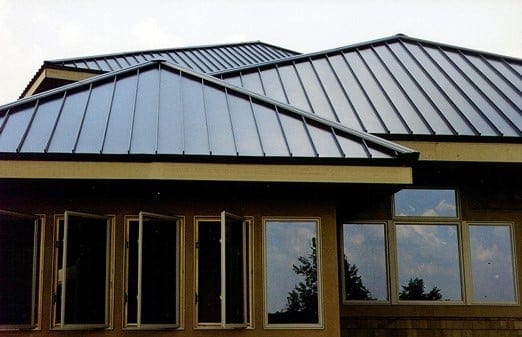
Best Types of Metal Roofing in 2023
As we navigate through the year 2023, one trend stands out in the roofing industry – the rising popularity of metal roofing. Renowned for its durability, aesthetic versatility, and energy efficiency, metal roofing has emerged as a top choice for homeowners seeking a long-term roofing solution. In this blog, we explore the best types of metal roofing available in 2023, highlighting the unique benefits of each to help you make an informed choice.
GET ROOFING QUOTES NOW1. Steel Roofing
Steel remains one of the most popular metal roofing materials due to its strength, longevity, and affordability. It’s a great choice for both residential and commercial properties. Steel roofing comes in three primary forms:
- Galvanized Steel: This is the most common type of steel roofing. It’s made by coating steel with a layer of zinc, which helps to prevent corrosion. Galvanized steel is extremely durable and is a cost-effective choice for homeowners on a budget.
- Galvalume Steel: A step up from galvanized steel, Galvalume is steel coated with a mixture of aluminum, zinc, and silicon. This combination offers improved corrosion resistance, especially in coastal areas where salt spray can accelerate rusting.
- Weathering Steel: Also known as COR-TEN steel, this material is designed to form a protective layer of rust when exposed to the elements. This rust layer protects the steel underneath from further corrosion, making it a good choice for architectural applications where a rustic appearance is desired.
2. Aluminum Roofing
Aluminum is lightweight, corrosion-resistant, and performs exceptionally well in coastal environments where corrosion is a significant concern. While it’s more expensive than steel, its superior resistance to rust and longevity can make it a cost-effective choice in the long run. Aluminum roofing is also environmentally friendly; it’s often made from recycled materials and can be recycled again at the end of its life.
3. Copper Roofing
Copper is the premium choice when it comes to metal roofing. With its distinctive aesthetic appeal, copper can add a touch of elegance to any building. Beyond its aesthetics, copper offers unmatched durability and can last for centuries. Over time, copper roofs develop a beautiful patina that enhances their appearance. However, copper is the most expensive metal roofing material.

4. Zinc Roofing
Zinc is a highly sustainable and eco-friendly roofing choice. It’s known for its ability to ‘self-heal’ from scratches and minor damages, making it exceptionally durable. Like copper, a zinc roof can last for centuries and develops a protective patina over time. While less expensive than copper, zinc is still more costly than steel or aluminum.
5. Tin Roofing
While not commonly used anymore, ‘tin’ is a term often used to refer to steel roofing. True tin roofing, however, is made from rolled steel coated with tin. Modern tin roofs are typically made from other materials and simply coated with a tin mixture.
The best type of metal roofing for your home or business will depend on various factors, including your budget, the climate in your area, and the look you’re aiming to achieve. While steel and aluminum offer affordable and durable choices, copper and zinc provide premium options that can last for centuries. Regardless of the material you choose, a metal roof can provide a durable, attractive, and energy-efficient solution that stands the test of time. As 2023 unfolds, it’s clear that the trend towards metal roofing is here to stay, offering homeowners a solid return on their investment and a sustainable choice for the future.
GET ROOFING QUOTES NOWWhat are the Benefits of Metal Roofing? A Sustainable Choice for Residential Homes
Metal roofing has seen a surge in popularity in recent years, especially in the United States, where homeowners are increasingly looking for durable, cost-effective, and eco-friendly roofing options. Here, we delve into the key benefits of installing a metal roof system.
Durability and Longevity
One of the primary benefits of metal roofing panels is their superior durability. Unlike an asphalt roof, which typically requires replacement every 15 to 20 years, a metal roof can last 50 years or more with proper maintenance. Metal roofing systems can withstand high winds, hail, and severe storms, reducing the need for repairs and maintenance.
Energy Efficiency
Metal roofing is an excellent insulator, which can significantly reduce energy costs. During summer, the reflective surface of metal roofing panels deflects the sun’s heat, keeping your home cooler and reducing the strain on your air conditioning system. In the winter, a metal roof helps retain heat inside your home, reducing heating costs.
Fire Resistance
Metal roofing materials are noncombustible, making them a safe choice in areas prone to wildfires. This fire resistance can also be beneficial in the event of a lightning strike or if fire embers fall on the roof.

Environmental Friendliness
For environmentally conscious homeowners in the United States, metal roofing systems offer an eco-friendly alternative to traditional asphalt shingles. Metal roofs are often made from recycled materials and are 100% recyclable at the end of their life. In contrast, used asphalt shingles often end up in landfills.
Aesthetics and Versatility
With a wide range of styles, colors, and finishes available, metal roofing panels can enhance the aesthetic appeal of residential homes. Whether you prefer the modern look of standing seam metal roofs or the traditional appearance of metal shingles that mimic wood shake, slate, or tile, there’s a metal roofing option to complement your home’s architecture.
Cost-Effective
While the initial cost per square foot of a metal roof system can be higher than asphalt shingles, the long-term savings make it a cost-effective choice. Given their durability, metal roofs require fewer repairs and less maintenance. When you factor in the energy cost savings and the potential increase in your home’s resale value, a metal roof is a wise investment.
GET ROOFING QUOTES NOWThe benefits of metal roofing panels make them an increasingly popular choice for residential homes in the United States. With their durability, energy efficiency, fire resistance, and aesthetic appeal, metal roofing systems offer a superior alternative to traditional asphalt roofing. While the upfront costs can be higher, the long-term savings and environmental benefits make metal roofs an excellent investment for homeowners seeking a sustainable, long-lasting, and cost-effective roofing solution.



Comparison of Different Types of Metal Roofs: Copper, Steel, Aluminum, and Zinc
Choosing a metal roof material is a critical decision for homeowners as it directly impacts the roof’s longevity, aesthetic, and price. In our previous discussion, we broadly categorized the best types of metal roofing available in 2023. Now, let’s delve deeper into the specific advantages and disadvantages of various metal roof materials, namely copper, steel, aluminum, and zinc.
Copper Roofing
Copper roofing is often considered the Cadillac of metal roofing, offering both unparalleled beauty and durability.
Advantages
- Longevity: Copper roofs can last for centuries, outliving the building they’re protecting in some cases.
- Patina: Over time, copper develops a unique green-blue patina that provides additional protection against the elements and adds a unique aesthetic touch.
- Lightweight: Copper is a lightweight material, reducing the load on a home’s structural support system.
Disadvantages
- Price: Copper is one of the most expensive metal roofing materials, which can be a barrier for many homeowners.
- Expansion/Contraction: Copper expands and contracts with temperature fluctuations. Over time, this can lead to loosening of the fasteners and require additional maintenance.
Steel Roofing
Steel roofing is a popular choice among homeowners for its balance of cost and durability.
Advantages
- Cost-Effective: Steel is among the most affordable metal roofing materials.
- Variety: Steel roofing comes in a wide range of styles and finishes, providing numerous aesthetic options.
Disadvantages
- Rust Potential: Even though modern steel roofs are coated for corrosion resistance, if the coating is compromised, there is a potential for rust.
- Heavier: Steel is heavier than other metal roofing materials like aluminum or copper, which can add to the load on a building’s structure.
Aluminum Roofing
Aluminum roofing is favored for its lightweight and resistance to corrosion, making it ideal for coastal areas.
Advantages
- Corrosion Resistance: Aluminum naturally resists corrosion, making it an excellent choice for homes in coastal areas where saltwater corrosion is a concern.
- Lightweight: Aluminum is lighter than steel, reducing the load on a home’s structural support system.
Disadvantages
- Cost: Aluminum roofing is more expensive than steel.
- Durability: While aluminum is durable, it’s generally not as tough as steel and might dent more easily.
Zinc Roofing
Zinc roofing, while not as common as other materials, offers unique advantages.
Advantages
- Self-Healing: Zinc has the unique ability to ‘self-heal.’ If the roof gets scratched, zinc reacts with moisture and carbon dioxide to create zinc carbonate, which prevents further corrosion and repairs the scratch over time.
- Longevity: Like copper, zinc roofs can last for a very long time, often over 100 years.
Disadvantages
- Cost: Zinc is more expensive than steel or aluminum, though it’s usually cheaper than copper.
- Appearance: The patina that develops on zinc roofs over time isn’t appealing to everyone.



Each metal roofing material—copper, steel, aluminum, and zinc—has its own set of advantages and potential drawbacks. While copper and zinc offer superior longevity, steel and aluminum are generally more affordable. The choice ultimately depends on your budget, your home’s location, the look you want to achieve, and how long you plan to stay in your home. Understanding the specific characteristics of each material will enable you to make the best choice for your unique situation.
The Installation Process of Metal Roofs: A Comprehensive Guide
A well-installed metal roof can provide decades of protection for your home. But understanding the installation process is vital for homeowners considering this durable and cost-effective roofing option. Here, we discuss what the metal roof installation process entails, the typical timeframe, and why it’s essential to hire experienced professionals.
GET ROOFING QUOTES NOWThe Metal Roof Installation Process
- Initial Assessment: The first step in any roofing project is a thorough inspection and assessment of the existing roof. This will allow the professionals to understand the project’s scope, check for any structural issues, and plan for any repairs or preparations needed before the new roof installation.
- Removing the Old Roofing Material: Depending on the state of your current roof, it may be necessary to remove the existing roofing material. While metal roofing can sometimes be installed over an old roof, in many cases, it’s better to start fresh to avoid trapping moisture or covering damaged areas that could worsen over time.
- Preparing the Roof Deck: Once the old roof is removed, the next step is preparing the roof deck. This often involves repairing any damage and installing an underlayment, which provides an additional layer of protection against moisture and helps ensure a smooth, flat surface for the metal panels.
- Installing the Metal Roof: Now comes the actual installation of the metal roof. The process begins with the edges, where drip edges are installed to direct water away from the fascia and into the gutters. Then, metal panels are carefully measured, cut to size, and secured to the roof deck. The panels are usually installed starting from the bottom and moving upwards, with each panel overlapping the one below it to create a waterproof seal.
- Finishing Touches: Once all panels are in place, the roofers will install flashing around any roof penetrations like chimneys or vent pipes and along the valleys to prevent water leakage. The final step is the installation of the ridge cap, which covers the seam along the peak of the roof.
Timeframe for Installation
The timeframe for a metal roof installation varies depending on the size and complexity of the roof, as well as weather conditions. However, most residential metal roofs can be installed in 3 to 5 days.


Why Hire Experienced Professionals
While a DIY approach may be tempting, metal roofing installation is a complex process that requires specific knowledge and skills. A poorly installed roof can lead to issues like leaks, poor insulation, and a shorter lifespan for your roof.
Experienced professionals understand the intricacies of installing a metal roof system, ensuring that it’s done correctly, safely, and efficiently. They’ll also be able to handle any unexpected issues that arise during the installation process.
A properly installed metal roof can offer superior protection, energy efficiency, and longevity for your home. By understanding what the installation process entails, you can be better prepared for what to expect during your roofing project. While installing a metal roof may be a significant investment, its durability and longevity make it a cost-effective choice in the long run. As with any significant home improvement project, ensure that you’re working with experienced and trustworthy professionals to guarantee a successful and hassle-free installation.
GET ROOFING QUOTES NOWMaintenance of Metal Roofs: Prolonging the Lifespan of Your Investment
Investing in a metal roof is just the first step; maintaining it properly is what ensures its durability and longevity. Fortunately, one of the great benefits of metal roofing is its low maintenance requirement compared to other roofing types. Still, some routine checks and minor cleaning can go a long way in keeping your roof in peak condition. Here are some tips on how to maintain and prolong the lifespan of a metal roof.
Cleaning Your Metal Roof
Over time, dirt, debris, and mildew can accumulate on your roof. Regular cleaning helps maintain the roof’s aesthetics and overall health. Here’s how to do it:
- Safety First: Cleaning a roof can be a dangerous task. If you’re not comfortable doing it yourself, consider hiring a professional cleaning service.
- Mild Cleaning Solution: Use a mild cleaning solution like water and dish soap to clean your metal roof. Avoid using harsh chemicals that could damage the metal’s finish.
- Gentle Cleaning Tools: Use a soft brush or a low-pressure washer to clean your roof gently. A high-pressure washer could potentially damage the paint or coating on the roof.
- Focus on Problem Areas: Pay special attention to areas where debris like leaves, twigs, or pine needles may accumulate, such as valleys or the areas around chimneys or vent pipes.




Periodic Inspections for Damage
It’s essential to conduct routine inspections of your metal roof to identify any potential issues early. Look for:
- Loose or Missing Fasteners: These can cause leaks or make the roof vulnerable to high winds.
- Scratches or Chips in the Finish: These can lead to rust over time if left untreated.
- Damage Around Roof Features: Check for signs of wear or damage around features like skylights, chimneys, or vent pipes.
- Debris: Clear away any debris from the roof surface and clean out the gutters regularly.
When to Seek Professional Repair Services
While regular maintenance and inspection can handle most minor issues, there are times when professional repair services may be necessary. If you notice signs of severe damage, such as large dents, buckling panels, rust, or leaks, it’s best to call a professional roofer. They can assess the situation and perform necessary repairs to ensure your roof continues to protect your home effectively.
Metal roofs are known for their durability and longevity, but regular maintenance is still key to ensure they stay in top condition. By cleaning your roof regularly, inspecting it for damage, and seeking professional help when necessary, you can prolong your roof’s lifespan and keep it looking its best for years to come. Just like any other significant part of your home, taking care of your metal roof is an investment in your home’s value, comfort, and protection.
Cost-Benefit Analysis of Metal Roofs vs. Traditional Roofs: A Deeper Dive into Long-Term Savings
One of the primary factors homeowners consider when choosing a roofing material is cost. However, the cheapest option isn’t always the most cost-effective in the long run. In this section, we’ll perform a cost-benefit analysis of metal roofs versus traditional roofs, using actual cost estimates to provide a clearer picture of potential long-term savings.
The Upfront Costs: Metal Roofs vs. Traditional Roofs
On average, as of 2023, a metal roof in the United States can cost anywhere between $10,000 to $20,000 for a standard-sized home, including materials and installation. In contrast, an asphalt shingle roof, which is one of the most common traditional roofing materials, typically costs between $5,000 to $10,000.
Tile and wood roofs, other common traditional roofing materials, can cost considerably more, with tile roofs often matching or exceeding the cost of a metal roof, and wood roofs typically falling in a price range between asphalt shingles and metal roofs.



The Longevity Factor
While metal roofs have higher upfront costs, their superior durability offers significant cost savings over time. Metal roofs can last 50 years or more with proper maintenance, while asphalt shingle roofs typically last 20 years. Tile and wood roofs can last longer than asphalt – usually 30 to 50 years – but still generally don’t last as long as metal roofs.
This means that over the lifespan of a metal roof, homeowners with asphalt, wood, or tile roofs may have to replace their roof two to three times, significantly increasing their total roofing costs.
GET ROOFING QUOTES NOWMaintenance and Repair Costs
Metal roofs also generally have lower maintenance and repair costs than traditional roofing materials. While an asphalt, wood, or tile roof may require periodic repairs due to damage from weather or wear and tear, a metal roof is more resistant to these issues.
Energy Efficiency Savings
Metal roofs can also provide substantial energy cost savings. Because they reflect heat instead of absorbing it, metal roofs can reduce cooling costs by 10-25%, providing ongoing savings throughout the life of the roof.
Resale Value
Investing in a metal roof can also increase your home’s resale value. Prospective buyers often value the durability, energy efficiency, and low maintenance requirements of a metal roof. According to a report by Remodeling Magazine, homeowners who install a metal roof can expect to recoup an average of 85.9% of the costs.
While the upfront costs of a metal roof are higher than some traditional roofing materials, the long-term cost benefits make it a financially savvy choice. Its superior durability, low maintenance, energy efficiency, and potential to boost resale value all contribute to its overall cost-effectiveness. By choosing a metal roof, homeowners can enjoy peace of mind and significant savings over their roof’s lifespan.
Case Studies of Metal Roof Installations: Real-Life Examples of Metal Roof Advantages
There’s no better way to understand the benefits of a metal roof than by exploring real-life examples. Below, we share a few case studies that demonstrate how homeowners have benefited from the durability, energy efficiency, and aesthetic appeal of metal roofs.
Energy Efficiency in Florida
A homeowner in sunny Florida decided to replace their asphalt shingle roof with a metal roof. The state’s tropical climate meant high air conditioning costs, especially during the hot summer months. After installing a reflective metal roof, they noticed a significant drop in their energy consumption. Their new roof reflected the sun’s heat away from the house, reducing the strain on their air conditioning system and slashing their energy bills by up to 20%.



Durability in Tornado Alley
Living in Oklahoma’s “Tornado Alley,” a family frequently experienced severe weather, including high winds and hail storms. Their original wood shingle roof needed repairs after almost every major weather event, leading to escalating maintenance costs. After researching different roofing materials, they opted for a metal roof due to its superior durability. Years later, despite numerous storms, their metal roof has stood strong with no need for repairs.
Resale Value in California
In California, a couple planning to sell their home decided to replace their aging tile roof with a sleek standing seam metal roof. Not only did this upgrade improve the home’s curb appeal, but it also proved a significant selling point. Potential buyers were drawn to the long lifespan and low maintenance requirements of the metal roof. As a result, the couple was able to recoup nearly their entire investment in the roof when they sold their home.
GET ROOFING QUOTES NOWLow Maintenance in the Snowy Northeast
In the snowy Northeast, a homeowner struggled with the constant need to clear snow from their asphalt shingle roof to prevent ice dams. After a particularly bad winter led to water damage from an ice dam, they decided it was time for a change. They chose a metal roof for its snow-shedding abilities. The slick surface of the metal roof allows snow to slide off easily, virtually eliminating the risk of ice dams. Since the installation, they’ve enjoyed worry-free winters regardless of the snowfall.
These real-life examples illustrate how a metal roof can offer tangible benefits, from reduced energy costs to enhanced durability, increased resale value, and decreased maintenance needs. While the upfront cost of a metal roof can be higher than traditional roofing materials, the long-term benefits make it a wise investment for many homeowners. The durability, energy efficiency, and low maintenance requirements of metal roofs translate into peace of mind and significant savings over time.


Frequently Asked Questions about Metal Roofs: Dispelling Myths and Offering Clarity
When considering a metal roof for their homes, homeowners often have a series of questions and concerns. These questions are vital in making an informed decision and dispelling some common misconceptions about metal roofs. Here, we answer some of the most frequently asked questions about metal roofs.
Do Metal Roofs Make a Lot of Noise When It Rains?
One of the biggest misconceptions about metal roofs is that they are noisy in the rain. However, metal roofs installed over a solid roof deck with proper insulation and underlayment are no noisier than other roofing types. The insulation and underlayment materials absorb the sound of the rain, resulting in a noise level comparable to that of an asphalt shingle or tile roof.
Can Metal Roofs Rust?
While rust is often a concern with metal objects, modern metal roofs are designed to resist rust. They are coated with a durable painted or stone-coated surface that protects the metal from the elements and prevents rust. Zinc or a combination of zinc and aluminum is often used in the coating for additional protection. With proper care and maintenance, rust shouldn’t be a concern for homeowners with metal roofs.




How Do Metal Roofs Perform in Different Climates?
Metal roofs are incredibly versatile and can perform well in various climates. In hot climates, metal roofs reflect solar radiant heat, which can reduce cooling costs. In cold climates, metal roofs shed snow and ice, preventing ice damming. They are also resistant to damage from strong winds, making them suitable for areas prone to hurricanes or heavy storms.
Do Metal Roofs Attract Lightning?
A common myth is that metal roofs attract lightning. In reality, the material of a roof does not increase the likelihood of a lightning strike. While metal can conduct electricity, lightning is not drawn to it. Metal roofs are considered safe in a thunderstorm and can even be beneficial if a strike does occur because the energy is dispersed throughout the roof rather than being concentrated in one spot.
Can I Walk on a Metal Roof?
Walking on a metal roof should be done with care, as it can be slippery and potentially dangerous. It can also potentially damage the finish of the roof. If it’s necessary to walk on your metal roof, it’s best to hire a professional who knows how to do so without causing damage.
As with any major home improvement decision, it’s essential to separate fact from fiction when considering a metal roof. Metal roofs are durable, versatile, and cost-effective roofing solutions that perform well under a variety of conditions. If you’re considering a metal roof for your home, make sure you’re well-informed, and don’t hesitate to seek out professional advice to answer any further questions you may have.
GET ROOFING QUOTES NOW
Leave a Reply